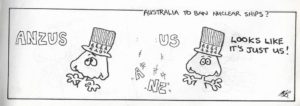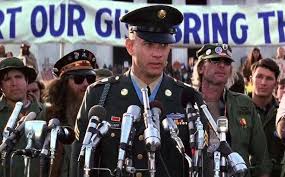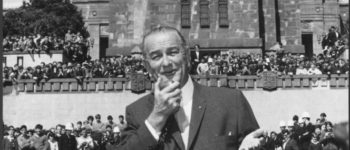1966: US President in New Zealand
October 19, 2020
By AHNZ
 Today in New Zealand History, 19 October, 1966, the President of the United States himself came by for a visit. You might think that the man prosecuting a very unpopular war against Vietnam at the time would be hated but, no, it was too early for that.
Today in New Zealand History, 19 October, 1966, the President of the United States himself came by for a visit. You might think that the man prosecuting a very unpopular war against Vietnam at the time would be hated but, no, it was too early for that.
US Relations was still pretty great and POTUS, Lyndon Johnson (LBJ,) was welcomed enthusiastically. So had his Vice President been earlier in the year whereas President Nixon’s VP was much hated during his visit. On the other hand, when President Clinton (out of office) visited in 2002 he was very well received, as would have been President Obama I’m sure. President Trump would not be welcome in my (and everyone’s) opinion so we might say that it’s Republicans (eg Nixon) who are not welcome not Democrats (eg LBJ.)
“About the long forgotten dockside guarantees”¹
President LBJ’s quick 24hr popularity tour was to a purpose. It was election year and National 2.0 wanted to be re-elected in November. LBJ helped the campaign, as did the September visit by the popular Queen Mother. Visiting royalty or celebrity used to be a staple of New Zealand politics going back as far as Lord Kitchener (1910) and beyond. Athletes and even submarines have also been used for the same affect.
 National 2.0 bought themselves a bit of LBJ face time for the nation and also paid the premium on some insurance just in case New Zealand would be attacked in the future and need defending. The later quid pro quo had certainly expired without any accident claims at the end of 20 more years. In 1987, Labour 4.0 cut New Zealand out of the ANZUS alliance entirely by their Nuclear Free Zone, Disarmament, and Arms Control Act. This old 1966 ‘dockside guarantee’ became long forgotten (to quote the Cold Chisel song.)
National 2.0 bought themselves a bit of LBJ face time for the nation and also paid the premium on some insurance just in case New Zealand would be attacked in the future and need defending. The later quid pro quo had certainly expired without any accident claims at the end of 20 more years. In 1987, Labour 4.0 cut New Zealand out of the ANZUS alliance entirely by their Nuclear Free Zone, Disarmament, and Arms Control Act. This old 1966 ‘dockside guarantee’ became long forgotten (to quote the Cold Chisel song.)
But what was in this for the Johnson administration?
“1966: President Lyndon Johnson personally visits New Zealand to solicit more Kiwi military support for his Vietnam War. PM Holyoake wasn’t happy about it, responding with a token increase. In 1970 PM Kirk tells the Yanks to shove it entirely, withdrawing all troops from a war running into 1975”- AHNZ
Yes, of course, it was the time of the Vietnam War. For New Zealand this was a small step in terms of military aid but a giant leap in terms of the extension of political credit.
New Zealand and ‘Nam
 Johnson needed international support for what he was trying to do in Vietnam and New Zealand’s was for sale. One Johnson’s spy-boats had crossed into enemy waters which the North Vietnamese tried to fend off with some little torpedo boats of their own in the Gulf of Tonkin in 1966. Johnson’s administration exaggerated the reports of this incident to create the great Vietnam War as we know it but the credibility for doing so was thin without some other nations to nod their heads and go along with it.
Johnson needed international support for what he was trying to do in Vietnam and New Zealand’s was for sale. One Johnson’s spy-boats had crossed into enemy waters which the North Vietnamese tried to fend off with some little torpedo boats of their own in the Gulf of Tonkin in 1966. Johnson’s administration exaggerated the reports of this incident to create the great Vietnam War as we know it but the credibility for doing so was thin without some other nations to nod their heads and go along with it.
Britain had been pretty great at colonising, putting a high premium on bringing the colonised into the new administrations they set up. This is a major reason why the Maoris greatly desired that the British, not the French, would be the ones to claim New Zealand. The people of Vietnam, on the other hand, had the misfortune to be colonised by the French and their system. Dissenters and the different were not welcome voices within a French colony, they were on the outside looking in. Branded as pirates, enemies, seditious, the enemies of the French State would have their heads guillotined as shown in the image above. When this colonial style finally failed and the French were booted out at last it left Vietnam in a divided state of civil war.
 The New Zealand film Sleeping Dogs (1977) explored C.K.Stead’s vision of New Zealand as a brutal dictatorship. In particular, if New Zealand had a civil war would we be free to settle it among ourselves? Or, would a foreign power pick a winner and give it weapons and resources? Would it prop up a regime the people did not support? For Kiwis these were soul-searching questions to discuss and explore in art; For the Vietnamese it was happening in real life.
The New Zealand film Sleeping Dogs (1977) explored C.K.Stead’s vision of New Zealand as a brutal dictatorship. In particular, if New Zealand had a civil war would we be free to settle it among ourselves? Or, would a foreign power pick a winner and give it weapons and resources? Would it prop up a regime the people did not support? For Kiwis these were soul-searching questions to discuss and explore in art; For the Vietnamese it was happening in real life.
In the end, New Zealand’s total contribution was 3,842 personnel of which 187 were wounded and 35 killed². Some were combatant but a medical team also saved the lives and patched up local civilians. After withdrawal, New Zealand’s Government contributed a children’s ward at Qui Nhon hospital where the Kiwi medics had worked. If there were any pictures of kiwis or silver ferns they were probably torn out when the Communists took over after the Fall of Saigon in 1975.
—
1 Ref. Khe Sanh, Cold Chisel (1978)
2. The Holyoake Years, Ross Doughty (1977)
Image ref. Dominion Post ; Alexander Turnbull Library
Image ref. Postcard of severed heads of Vietnamese “pirates” in 1880s French Indochina, “Pirates, highwaymen or resistance against colonization were hunted down by the French army, killed in fighting, imprisoned, tried, condemned or executed. The executions were carried out according to the rite of the Annamese law, law of the country, by beheading.”; INDOCHINA old postcards
Ref. New Zealand medics start work in South Vietnam; NZ History.govt
 Like Comment Share
Like Comment Share






